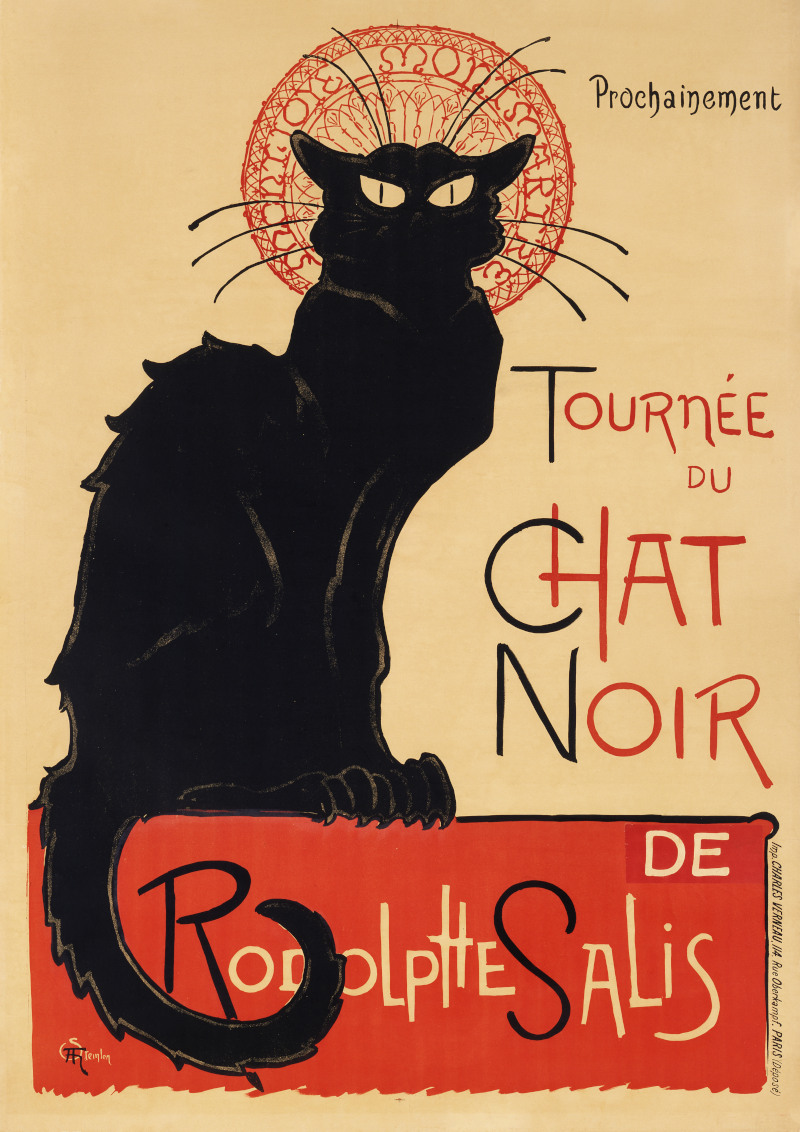There is little more charming within art than cats. Here we examine famous cat drawings from the past, and also discuss tips and techniques to produce your own cat drawings, relatively easily.
Introduction to Cat Drawings
Within this article we present a number of artworks which potentially can help to inspire your own musings, and we have purposely provided a range of artistic styles, mediums and compositions. Artworks date back several centuries, as we include a number of abstract works, as well as more vintage creations. You will be surprised by the amount of diversity that exists across this single genre, and should have plenty of ideas to work with by the end of this article.
Additionally, we have also discussed a number of issues related to cat art below the artworks, as well as provided information on the artists behind each work in short summaries. Cat drawings and paintings continue to be highly regarded, and a very accessible part of art history for everyone to enjoy, with much to be found within this article, though we have also covered elsewhere a number of related themes such as animal drawings, butterflies, birds and fish.
List of Cat Drawings and Paintings
We have sourced some wonderful cat images of historical artworks, most of which are courtesy of rawpixels, who provide copyright free images directly from the public domain. Feel free to use these for inspiration for your own work, and the variety included below should meet all tastes and requirements. Indeed, you yourself might trace the outlines of these artworks, or focus on greater detail, depending on the level that you are at, yourself.
We have also included a number of famous artists who focused on animals within their careers, and were able to produce highly charming artworks. This included Franz Marc, who became one of the most famous animal artists of recent times, and worked in an Expressionist manner in Germany in the early 20th century. Julie de Graag was another notable artist who regularly featured animals within her work, and made use of minimalist lines that relied on two-tone contrasts, often carved into wood before being printed.
Tournee du Chat Noir (Black Cat, 1896) by Theophile Alexandre Steinlen
The Black Cat by Theophile Alexandre Steinlen is perhaps the most famous cat painting of all time, and was produced as an advertising illustration poster to promote its cabaret nights in the late 19th century. The poster forms a large black cat with relatively little detail, other than some dark grey outlines which help to lay out the most minimal of details. This well structured work immediately captures your attention with the cat's eyes, before we scroll down the poster's right hand side, revealing the advertising message. The Art Nouveau era was full of inventive advertisement posters such as this, with other great contributors including Alphonse Mucha and Henri de Toulouse-Lautrec.
 by Theophile Alexandre Steinlen.jpg) Tournee du Chat Noir (Black Cat, 1896) by Theophile Alexandre Steinlen
Tournee du Chat Noir (Black Cat, 1896) by Theophile Alexandre Steinlen
Sleeping Cat by Kono Bairei
Another much loved cat painting comes from Kono Bairei, a respected Japanese artist from several centuries ago. In this charming piece we find a cat sleeping, whilst curled up on the floor. He adds touches of ink around the edges of the cat to give the impression of cat fur protruding from the animal, but otherwise the areas are full of solid color, perhaps from watercolors. The cat's orange color allows an additional tone into the palette, and this vintage artwork remains fairly suitable even today for a modern home, such was the approach taken by Japanese artists.
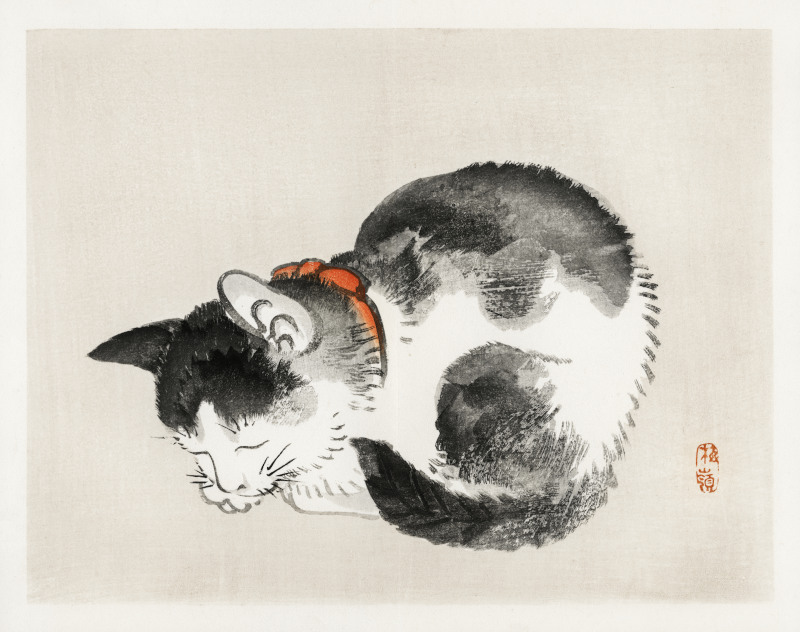 Sleeping Cat by Kono Bairei (public domain image, courtesy of rawpixels)
Sleeping Cat by Kono Bairei (public domain image, courtesy of rawpixels)
Cats by Thomas Hunter
This charming, highly detailed sketch by Thomas Hunter features two cats peering over the back of a chair. The level of precision within this piece helps it to achieve almost a photographic quality, and also enables it to still feel contemporary, all these years later. Considerable work was completed on the patterns around the cat's faces, and we can all recognise cats that we have come across in real life within this work.
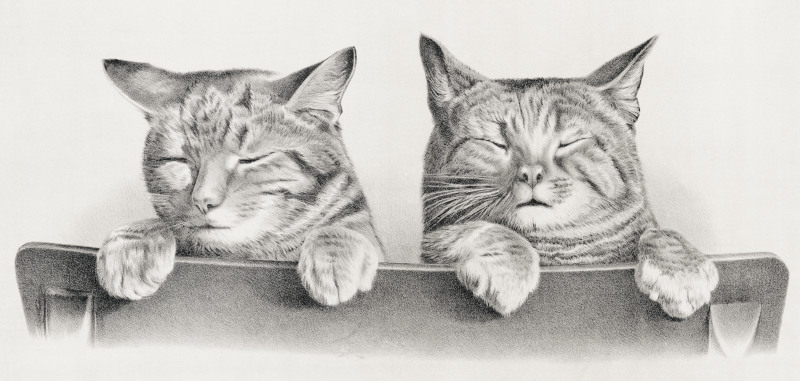 Cats by Thomas Hunter (public domain image, courtesy of rawpixels)
Cats by Thomas Hunter (public domain image, courtesy of rawpixels)
Sitting Cat by Julie de Graag
This delightful sitting cat by Julie de Graag helps to remind us of the qualities of this artist. She regularly etched into wooden blocks and created form using negative space. Her love for animals is evident in the charming nature of these depictions, but also in the large number of times that she featured different animals within her work. This Dutch painter is classed loosely within the Art Nouveau era, but her work was highly unique and in recent years has started to receive more attention once more, thanks to the timeless charm of much of her work.
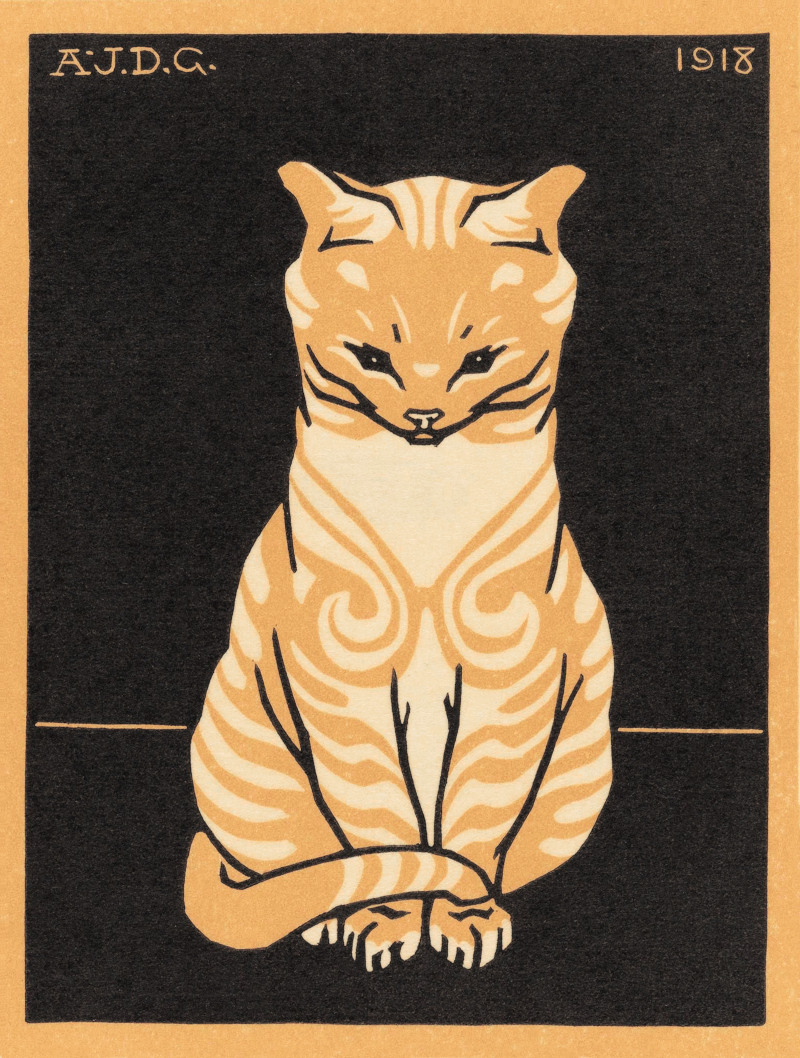 Sitting Cat by Julie de Graag (public domain image, courtesy of rawpixels)
Sitting Cat by Julie de Graag (public domain image, courtesy of rawpixels)
Simple, Easy Cat Sketch
This simple, quick sketch underlines a good method for those starting out with cat drawing. Individual strokes of the pencil can be seen here, and one can quickly understand how to go about forming an entire composition, one stage at a time. One might even trace this public domain piece as a means to learning the outlines and forms of this creature, and alot can be achieved with relatively few pencil or brush strokes.
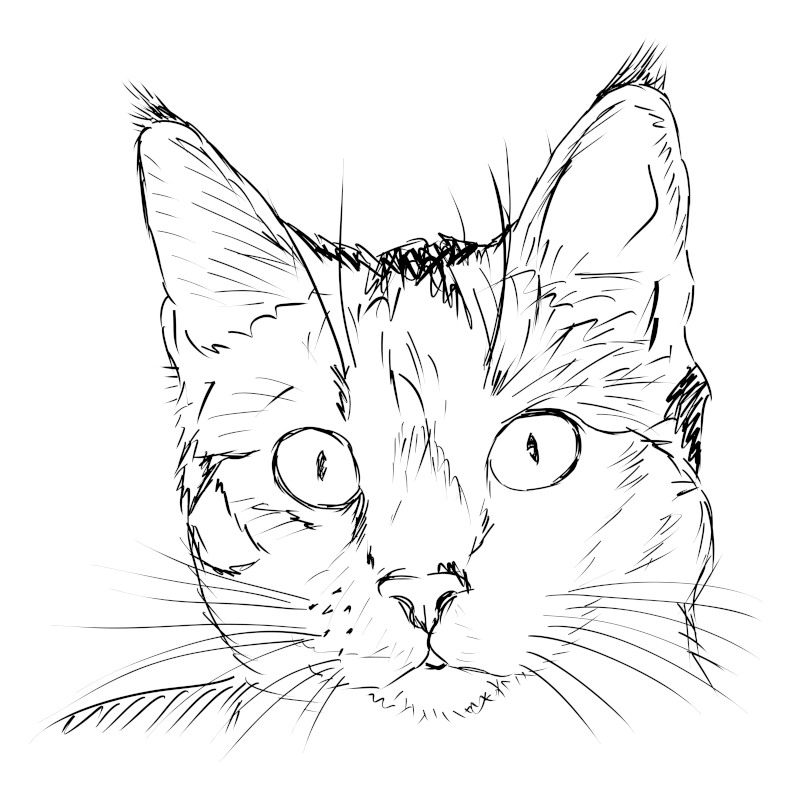 Simple, Easy Cat Sketch (public domain image, courtesy of rawpixels)
Simple, Easy Cat Sketch (public domain image, courtesy of rawpixels)
Sketch of a Cat by Jean Bernard
Jean Bernard was a highly skilled animal artist, as shown in this incredibly detailed and lifelike cat portrait. There is almost a photographic quality to this drawing, and it can be presented as a completed, presentable artwork, rather than a quick, experimental sketch. In this image, one can see some of the original texture of the paper on which this drawing was produced, and the palette is limited down to just a few colors, with the artist able to achieve subtle details through his own technical prowess.
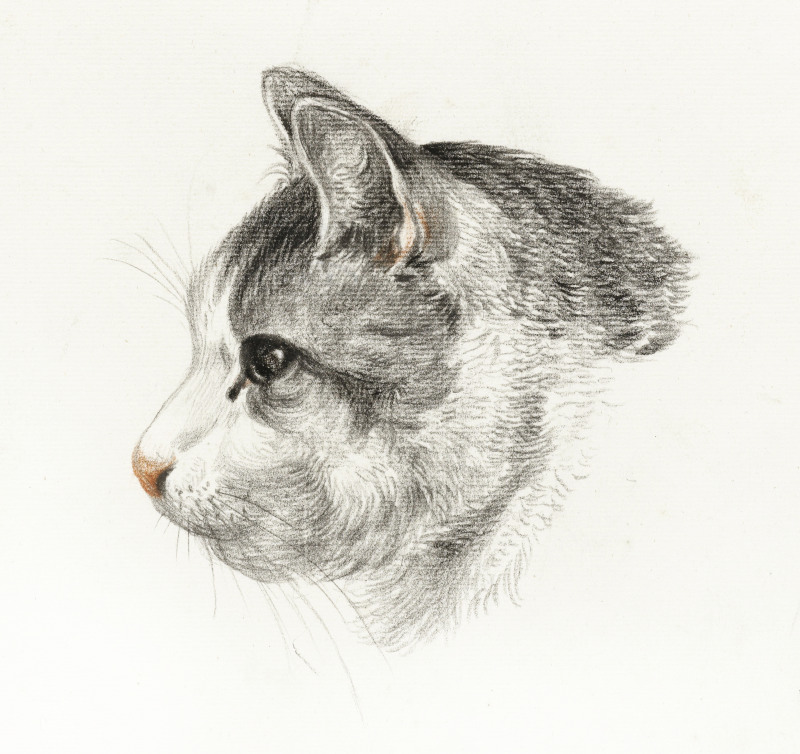 Sketch of a Cat by Jean Bernard (public domain image, courtesy of rawpixels)
Sketch of a Cat by Jean Bernard (public domain image, courtesy of rawpixels)
Sitting cat, from behind (1812) drawing in high resolution by Jean Bernard
 drawing in high resolution by Jean Bernard.jpg) Sitting cat, from behind (1812) drawing in high resolution by Jean Bernard (public domain image, courtesy of rawpixels)
Sitting cat, from behind (1812) drawing in high resolution by Jean Bernard (public domain image, courtesy of rawpixels)
Two cats, blue and yellow by Franz Marc
Franz Marc achieved great success with a great number of animal paintings during his short but impactful career. Perhaps he is best known for his Yellow Cow, but he covered different animal types, as shown with his two cats featured in the work below. There were also tigers, foxes and many other besides as he applied his expressionist approach to a wide range of creatures. His approach continues to draw support today, and remains modern in appearance, despite a whole century having passed since these paintings were completed.
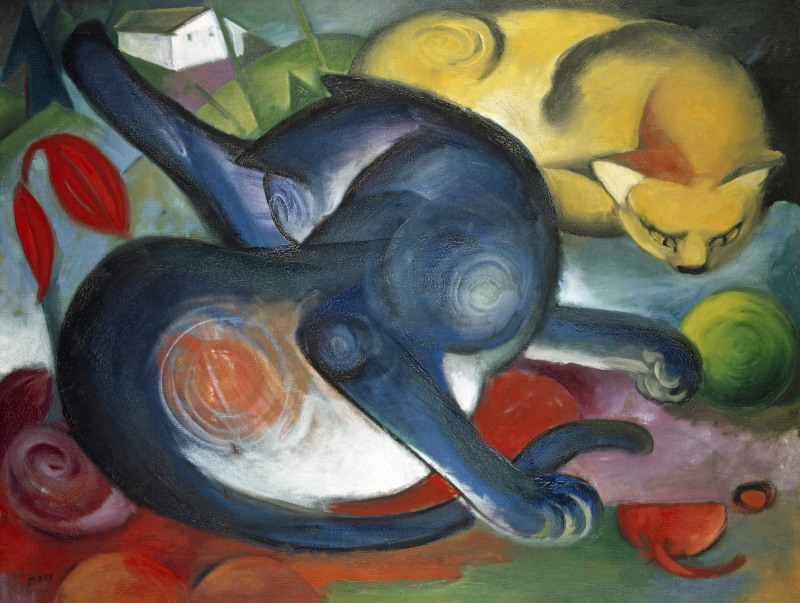 Two cats, blue and yellow by Franz Marc (public domain image, courtesy of rawpixels)
Two cats, blue and yellow by Franz Marc (public domain image, courtesy of rawpixels)
Cat Watching Sunrise Cartoon Drawing
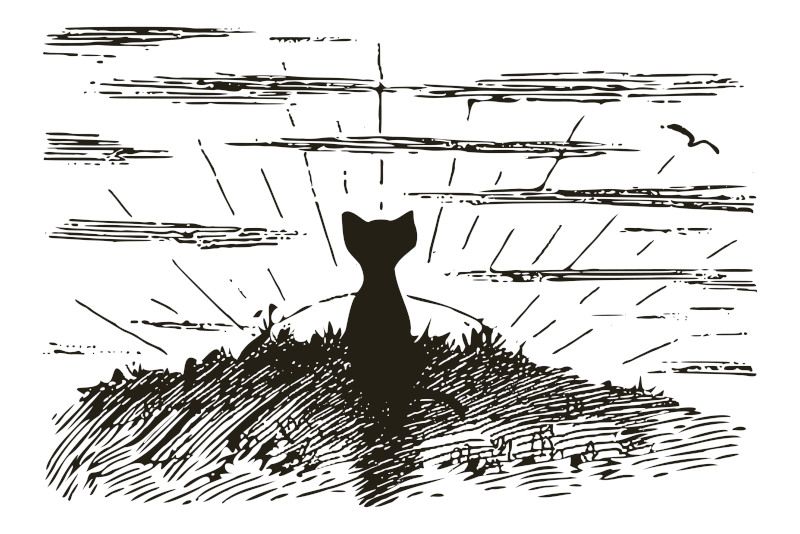 Cat Watching Sunrise Cartoon Drawing (public domain image, courtesy of rawpixels)
Cat Watching Sunrise Cartoon Drawing (public domain image, courtesy of rawpixels)
Cats under a tree by Edward Penfield
This somewhat unique artwork by Edward Penfield is composed in a particularly unusual manner, with a wide, horizontal format that allows two cats to stand either side of a small tree. Detail is kept to a minimum, giving this piece a relatively modern feel. Tones of orange, black and white are used cleverly to fill most of the scene, and this became one of the artist's best known works.
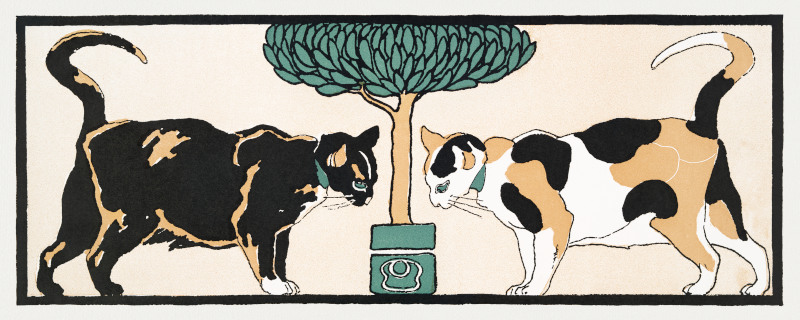 Cats under a tree by Edward Penfield (public domain image, courtesy of rawpixels)
Cats under a tree by Edward Penfield (public domain image, courtesy of rawpixels)
Vintage Christmas by Edward Penfield
This charming vintage christmas poster holds an Art Nouveau style to it and features a lady reading a book whilst being joined by her pet cat who relaxed patiently by her side. Christmas is emblazoned across the bottom of the poster, though in this example the main illustrations are allowed to take centrestage. In more promotional work, typically the name of a company, product or service will be given greater prominence in order to raise its profile through this medium, which was popular in the late 19th century.
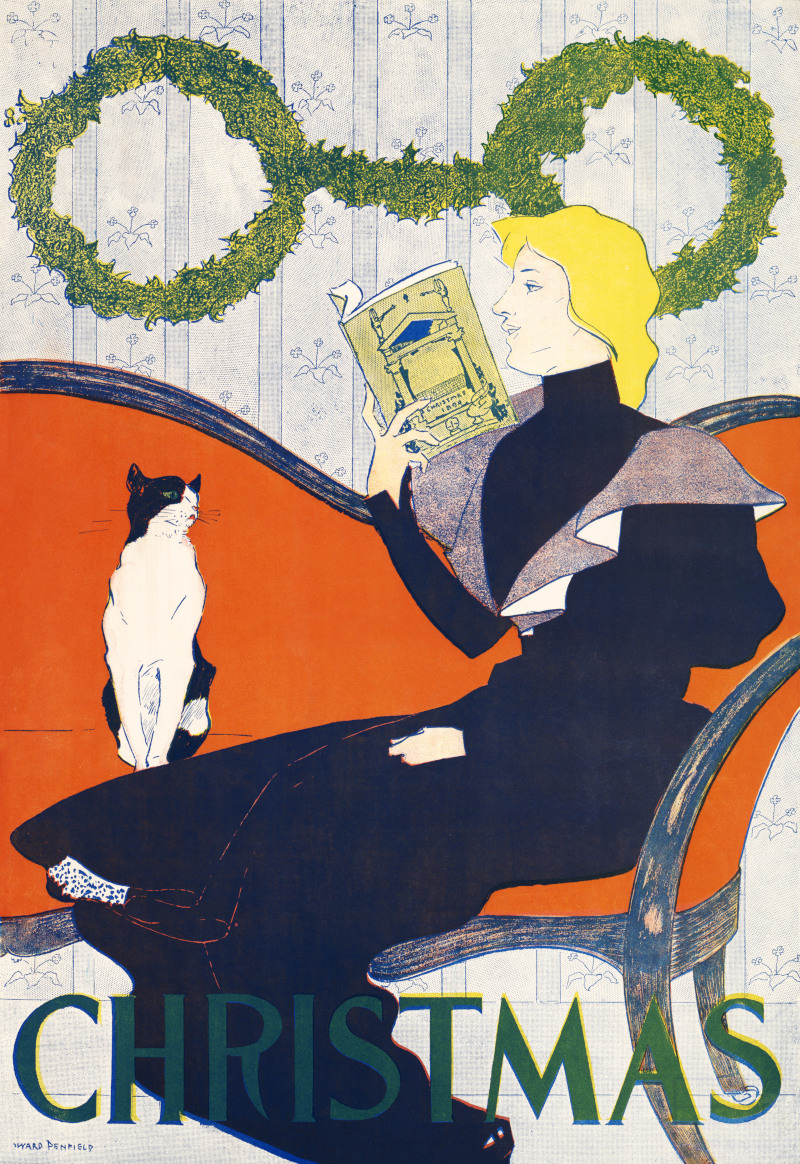 Vintage Christmas by Edward Penfield (public domain image, courtesy of rawpixels)
Vintage Christmas by Edward Penfield (public domain image, courtesy of rawpixels)
Waving Cat Cartoon Illustration
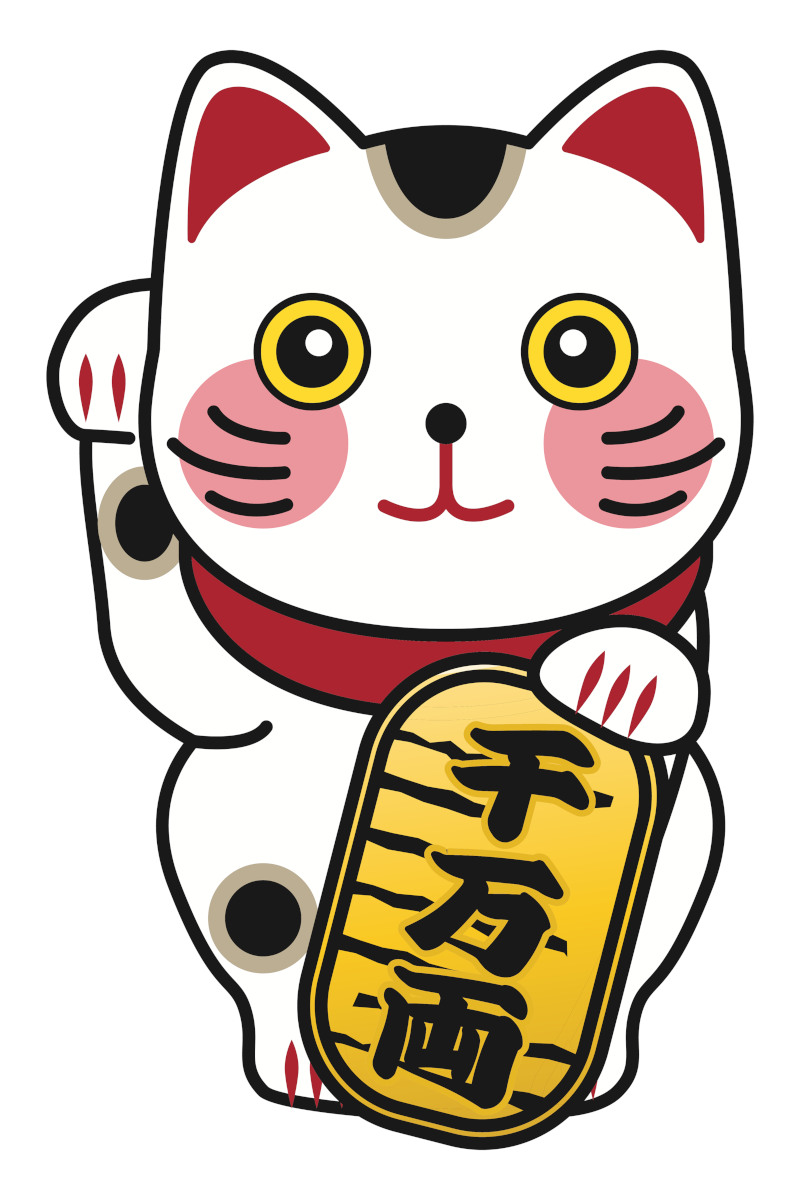 Waving Cat Cartoon Illustration (public domain image, courtesy of rawpixels)
Waving Cat Cartoon Illustration (public domain image, courtesy of rawpixels)
Japanese Print with Cat
This charming Japanese print features a lady in traditional dress, lying next to her cat. They look at each other, suggesting a strong bond and the white cat wears a pretty collar with bell. Much of the detail in this artwork is afforded to the lady's dress, which features a complex series of patterns that adds much to the aesthetic of this work. Japanese art regularly featured cats, with this animal enjoying a prominent role within the nation's culture, in a variety of ways.
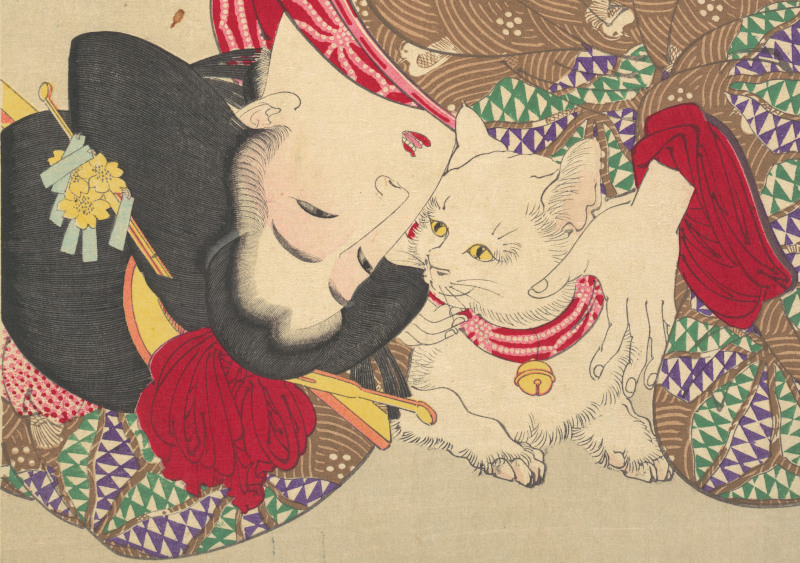 Japanese Print with Cat (public domain image, courtesy of rawpixels)
Japanese Print with Cat (public domain image, courtesy of rawpixels)
December Cat by Julie de Graag
Another cat artwork by Jule de Graag, this features a familiar posture in which the cat curls up and relaxed with its head down. The artist incorporates a pattern to match the fur, roughly following the contours. This brings tones of yellow and orange into play, which contrast beautifully against the black background. The viewer is not able to connect with the cat's line of sight, producing a different atmosphere within this work, as it just relaxed by itself, seeking tranquility.
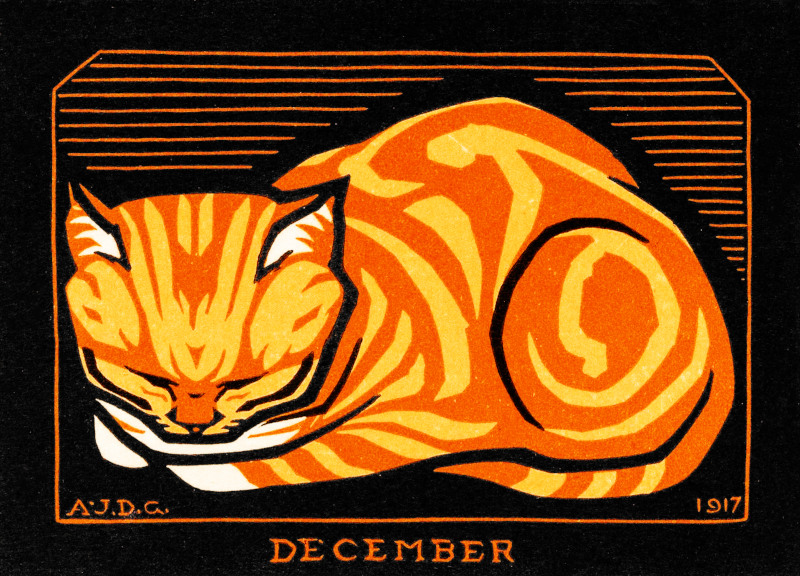 December Cat by Julie de Graag (public domain image, courtesy of rawpixels)
December Cat by Julie de Graag (public domain image, courtesy of rawpixels)
What is the History of Cat Art, Drawing and Painting?
Cats appeared within art from as early as the ancient civilizations. In some cultures they would carry symbolic values, such as fertility and grace, whilst others appreciated them for more pragmatic values, such as eradicating pests. This role in society alongside humans inevitably led to them appearing within art, including some of the very earliest of paintings. They appeared in wall paintings, for example, and were featured within mythology in connection to a number of godesses.
By the middle ages, some started to hold a negative impression towards cats, and they became connected to the threat of witchcraft. Many of their characteristics with which we are familiar today, such as their spirit of independence, were well known then, too, and they also were featured more positively in art during that period by others. As we moved into the Baroque era, their relationship with humans started to be reflected in art, and depictions of them started to become closer to reality, with a more accurate use of animal anatomy, more generally.
By the 20th century we would then start to see cats used in a more fun light, representing their role in many of our lives as domesticated creatures, with their own personalities. With precision mastered, new artists started to produce expressive and abstract forms of cats, and they would also start to appear within cartoons, often with new capabilities taken from humans.
Bringing Cats to Life: Painting Techniques and Mediums
There are many different techniques and tools available for cat drawing and painting, depending on the types of effects and styles that you want to achieve. One can amend both the tool of application, as well as the medium that receives it. Painting can make use of oils, watercolors and acrylics, each of which have their own advantages. Oils tend to produce the boldest of color, whilst watercolors are better for more subtle applications. For drawing, you can try charcoal, standard drawing pencils, pastels and many others, and will need to consider cost, color, and also the thickness of line that you might prefer.
You can then consider the style of the art itself - are you attempting to achieve incredible accuracy as found in animal art of the 18th and 19th century, where art and science would often work closely together. Or, are you attempting some more expressive and creative, where forms may be recognisable, but are also combined with the imagination of the artist to create something entirely unique. This is where the likes of Franz Marc would come in, and he achieved great success by working in this manner.
In terms of the technical aspects, the fur is a key consideration, as are other elements such as the eyes and whiskers, which help to identify each portrait as cats. We are more familiar with the appearance of cats than most other creatures, and so any errors will be obvious to most people pretty much immediately. It is normally advisable to slowly build up portraits over time, starting simple before adding more layers of complexity as you progress.
From Caricatures to Comics: Humor and Cats in Art
Cats have often been used, particularly in recent times, to create an atmosphere of fun and playfulness. In order to better deliver this message, many artists will exaggerate feline features, such as enlarging their eyes in order to focus more closely on their personality. Cartoons have taken this a stage further, even creating characters that have been re-used for decades, combining some of the best features of humanity and cats together into something highly palatable.
There is a very different role for domesticated animals within art, as compared to those who serve other purposes. Compare, for example, how dogs and cats might be used in 20th century art, and the likes of cows and horses by comparison. This artistic contrast represents the different relationships that we hold with different animals. That is not to say that other animals can't be used in cartoons in the same manner, but just that it works more smoothly when using animals that already live in our homes, as part of our everyday lives. Another aspects to that could be diet, in that animals that we refuse to eat may be seen differently.
Cat Art Unleashed: Exploring Abstract and Avant-Garde
Cats have been used in all manner of different art movements, and by the 20th century began to appear in Surrealism and Abtraction. They could be adapted for social commentary on a number of issues, and some artists felt that cats could better deliver some messages than humans. There are certain aspects to cats which are entirely unique, and these can be tapped into by abstract artists, with whiskers being the most obvious one. The curves of the cat can also be incorporated artistically.
Possibilities of Expression: Emotional Range in Cat Art
Cats are seen as more complex than dogs, with an intelligence that can prove both beneficial but also sometimes a drawback. They are not seen as having the same level of devotion as dogs, in part because of a strong feeling of independence, as well as an underlining self-interest. Some of these attributes can be used within art, using the most subtle of expressions and behaviors, because they already sit in the mind of the viewer. We are also highly accustomsed to the different postures of cats, which can range from shy to playful, friendly to hostile. In living with cats so closely, our understanding of these forms of body language as highly evolved, as compared to non-domesticated animals.
Cats can rest for hours on end, before lurching into a frenzy of activity, and there may not be much between the two. Posture, noise and activity help us to understand their moods and emotions. Changes can occur in the arching of their backs, movement of ears, general posture and more in order to cover their full range of emotions, and artists can incorporate these to produce very different atmospheres and messages within their work.
Masterpieces: Master Artists and Their Feline Subjects
There are famous artists who have dabbled with cats within lesser known parts of their career, such as Edward Hopper in the US. There are then others who have used cats, alongside other animals, to help boost their own artistic legacy, such as Franz Marc. Many of the latter were not involved in painting, but more likely in illustrations for books, cartoons or something similar. Until the 20th century, to reinvent a cat with human attributes would not have been acceptable, and precise replications for science were far more likely.
More recently, we have seen with the likes of Hello Kitty as to how cats can be used to create whole brands, with characters re-used time and time again in a cartoon format which the public regularly appreciate. Children's books will follow a similar approach, bringing animals to life for children by giving them clear personalities, such as with Peppa Pig. In many examples, the public would prefer adapted animal characters over humans, and take more interest in the stories as a result.
Pablo Picasso was very much an animal lover and used them as inspiration for a number of charming line drawings. These artworks specifically help to inspire us all, and indicate how much can be achieved with relatively little work. He was not concerned with accuracy or detail, but in a single line could create a recognisable form of all manner of different creatures, so long as he considered it for a short period first.
The Digital Whisker: Cat Art in the Digital Age
Digital cat illustrations can be iterated time and time again, as well as potentially being shared for collaboration purposes. Compare that with oil painting or watercolors, where corrections can be very time consuming, and in some cases not even possible. Digital software allows such amendments, whilst tools such as drawing tablets enable us to work on the move. Cat depictions can work internationally, with no prior knowledge necessary, and so the spread of the online would enables animal artists to gain a following right across the world, particularly through social media.
A further advantage of digital art is the ease with which designs can be re-purposed, when produced directly on a computer or device. Art can be translated into sellable products in just a few minutes, with artworks able to be expanded and shrunk without losing clarity, where formats such as svgs are used. A quick sketch could appear on a t-shirt, mug, or art print at relatively affordable costs without any further technical knowledge being required.



